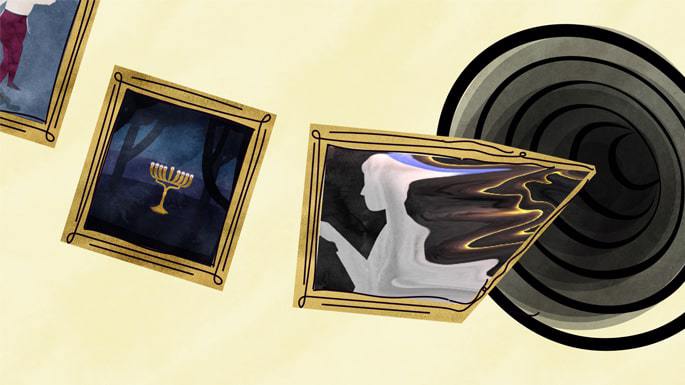As artificial intelligence (AI) continues to permeate our society, questions and challenges related to intellectual property rights and halachah have arisen. Among these concerns is the potential for AI to replicate content that belongs to others. To gain insight into this issue, let's delve into the Jewish perspective on intellectual property rights.
While the "Statute of Anne," enacted in England in 1710, is widely recognized as the world's first copyright law, the Jewish world grappled with this issue over a century earlier. In 1550, the printing of Moses Maimonides' magnum opus, the Mishneh Torah, sparked the first known intellectual property controversy in Jewish history.
The Italian Mishneh Torah Controversy
In Renaissance-era Italy, Jews were forbidden from printing books. Undeterred, Rabbi Meir ben Isaac Katzenellenbogen of Padua ("the Maharam Padua") devoted substantial time, effort, and resources to creating a new edition of the Mishneh Torah, complete with his commentary. He then enlisted Christian printer Alvise Bragadini to produce his work.
However, Bragadini's rival, Marc Antonio Giustiniani, published his own edition of the Mishneh Torah, incorporating the Maharam's annotations and undercutting the competition by one gold coin. The Maharam, feeling the sting of intellectual theft, sought recourse through Rabbi Moses Isserles of Krakow ("the Rama").
In a landmark ruling, the Rama deemed Giustiniani's actions as unfair trade practices and subsequently prohibited the sale or purchase of the rival edition until the original publisher's investment had been recouped.1 While the Rama lacked the jurisdiction to enforce his ruling upon an Italian non-Jew, he could implement a cherem (decree of ex-communication) that effectively barred Jews from buying, selling or facilitating the sale of the competing edition.
This groundbreaking decision set a precedent in Jewish publishing. It became customary for publishers to obtain a cherem from a respected Torah authority, which would prevent others from publishing the same sefer (book) for a specified period, typically ranging from five to twenty-five years.
By seeking haskamot (approbations) from esteemed rabbis, publishers were able to justify the resources required to produce a sefer. The cherem system proved instrumental in promoting the publication of Jewish books and the dissemination of Torah learning.
The Rödelheim Machzor Controversy
As the centuries unfolded, numerous disputes over intellectual property rights emerged in Jewish publishing. One such disagreement in the early 19th century centered around the Rödelheim machzor, a prayer book used during Jewish holidays.
Jewish scholar Wolf Heidenheim had dedicated significant resources to produce an enhanced version of this machzor and obtained a cherem from various prominent rabbis to safeguard his publishing rights. However, Anton Schmid, owner of a non-Jewish publishing house, released a less expensive edition of the machzor, incorporating Heidenheim's text without his revisions and annotations, and adding prayers and customs not present in Heidenheim's version. Schmid argued that his improvements did not infringe upon the cherem, as he did not reprint Heidenheim's edition word-for-word.
This controversy attracted the attention of leading Jewish scholars, resulting in a difference of opinion between Rabbi Moses Sofer (the "Chatam Sofer") and Rabbi Mordechai Benet. Rabbi Benet maintained that the cherem's purpose was to motivate publishers to print Torah works, and in the case of a widely-needed item like a machzor, a ban was unnecessary, as publishers would anticipate significant demand and profit. He also asserted that a cherem might inadvertently benefit non-Jewish publishers by reducing competition from Jewish publishers, who would be deterred by the ban.2
The Chatam Sofer, on the other hand, contended that Heidenheim's substantial investment in text correction deserved protection under a special halachic consideration, which aimed to encourage the investment of time, money and energy in publishing accurate texts.3
Inherent Intellectual Property Rights: A Matter of Debate
So far, we've explored rabbinic bans, which resemble copyrights, as primarily serving to encourage investment by authors, editors and printers.
But could it be that these individuals also possess ownership rights to their creative works (intellectual property)?
This question surfaced during the publication of the Pitchei Teshuvah, a commentary on the Code of Jewish Law by Rabbi Avraham Tzvi Hirsch Eisenstadt in the early 19th century. As was customary, the author secured a cherem from several respected rabbis to protect his rights and prevent others from copying his work. The commentary was published by Avraham Yosef Madfis ("Printer").
Yitzchak Dov Bamberger of Würzburg, however, released an unauthorized edition of the work, including his own notes and corrections. The original printer sued Bamberger, asserting that he had acquired exclusive rights from the author. Bamberger countered that his improvements did not breach the cherem, as he did not reprint the work verbatim.
Several rabbis weighed in on the dispute, offering differing rulings based on their understanding of Jewish law's stance on intellectual property. Three distinct approaches emerged.
First Approach: No Intellectual Property Rights
Rabbi Shmuel Valdberg of Zalkava, who initially presided over the dispute, ruled in favor of the second publisher. He argued that:
- There was no explicit cherem against printing a competing edition of the original work.
- The original edition was no longer available.
- The second publisher reproduced the work as part of a set of the Code of Jewish Law, providing a superior and more costly product.4
Rabbi Valdberg maintained that there are no inherent intellectual property rights, even for the author himself. He viewed the ban as a means to cultivate a favorable environment for publishing, and since the three aforementioned conditions did not apply, he saw no reason to prohibit the second printing.
Second Approach: Inherent Intellectual Property Rights
Rabbi Yosef Shaul Nathanson (1808–1875) of Lviv (Lemberg), author of Shoel Umeishiv, challenged Rabbi Valdberg's perspective:
And here all his words are puzzling. It is certain that in the case of a new book that is being printed by an author, who has merited that his words are universally accepted, it is obvious that he has a right to it forever. And in any case, if someone prints or renews some work, another is not allowed to do so without his permission . . . And regarding what he wrote that the author did not write a prohibition, behold, even if no prohibition were written, it would still be forbidden to infringe upon his rights . . .5
According to Rabbi Nathanson, Jewish law recognizes inherent intellectual property rights, which, unlike contemporary copyrights, last indefinitely. He further explained that many Jewish books included bans for a specified period because authors voluntarily relinquished their rights after recovering their investments. This allowed their works to be published posthumously, ensuring their legacies would live on.
Third Approach: The Law of the Land
Rabbi Yitzchok Shmelkes (1827–1905), author of Beit Yitzchok, proposed a third approach. He disagreed with Rabbi Nathanson, contending that there is no inherent intellectual property right from a Torah perspective. However, he argued that Jewish law adheres to the principle of dina demalchuta dina, meaning "the law of the government is law" in halachah.
In this case, Rabbi Shmelkes maintained that since government regulations recognized the author's intellectual property rights, the second publisher was not permitted to publish the work without authorization.6
Artificial Intelligence and Intellectual Property Rights
How do these three perspectives apply to AI-generated content?
- Rabbi Valdberg's view: Since he asserts that there are no inherent intellectual property rights, there would be no issue with AI appropriating creativity, as no rights are being infringed upon.
- Rabbi Shmelkes' view: If we follow his approach that Jewish law adheres to local government regulations, we would simply follow those laws regarding AI and intellectual property rights, once they have been clearly established.
- Rabbi Nathanson's view: Many believe (although there is no clear consensus) that halachah aligns with Rabbi Nathanson's perspective, which asserts that authors retain inherent rights to their intellectual property. However, even according to this opinion, barring any copyright laws or cherems, the prohibition only applies to republishing their work without permission. There are no restrictions against personal use of a copy that has been (illegally) produced if there is no real tangible loss to the author.7
Moreover, if the AI-generated work contains significant changes that make it barely recognizable compared to the original, it might not be considered the same product, and the author would not have rights to it. Therefore, there would not be any issue with using AI-generated art, even if it contains elements inspired by known artists' works.
Regardless of the specific perspective, it's important to remember that crediting others is a value cherished in Jewish teachings. As our sages say in Ethics of the Fathers, "One who says something in the name of its speaker brings Redemption to the world…"8




Join the Discussion